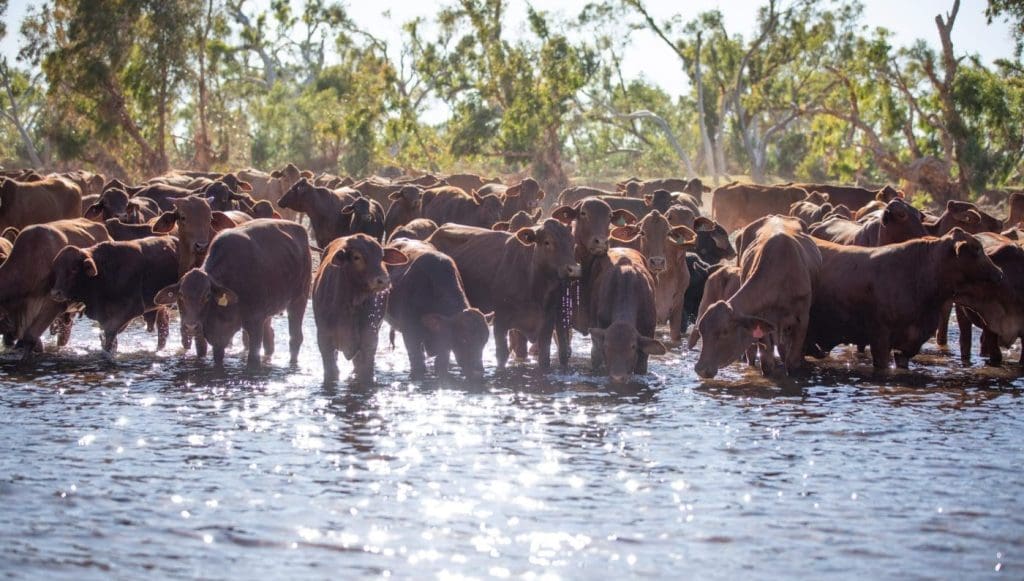
IN ANY beef breeding system, the primary driver of productivity and profitability is determined by the number of calves that can be born, and can be raised to weaning and on to sale weights.
There are numerous issues that can occur within a herd to impact on this. However, one of the most important, for both a calf and cow survival, is birth weight.
Producers would generally recognise the importance of managing birth weight to avoid high levels of dystocia in their herd. However, in extensively-run herds, dystocia is not the only risk producers are attempting to manage. Research conducted through programs such as Calf Alive have highlighted the increased risks to calf survival associated with very low birth weights.
Genetically, birth weight is a trait that producers can exert some influence over in their selection decisions.
Birth weight is a moderate to highly heritable trait. It is also a trait that is positively genetically correlated with liveweight at 200 and 400 days. The challenge for many producers is to balance their selection decisions in order to manage birth weights to avoid increasing the dystocia risk, without unduly compromising the subsequent growth of their calves to weaning and yearling weights.
As with any selection process, the accuracy of the information available to support decision-making is essential. The accuracy of any genetic evaluation lies in the collection of sufficient data to undertake an analysis and provide an EBV that is useful in supporting those decisions.
Collecting data, particularly around birth weights has challenged many producers. However, in southern Australia, there has been a long period of data collection and subsequent analysis. The EBVs published by most breeds reflect the dedication of breeders who have contributed records to ensure producers have access to information to support their decisions.
Challenges in extensively-managed herds
In more extensive herds, these challenges also exist and are magnified by challenges associated with distance, time, and the scale of operation within breeding herds.
This has made the process of collecting data for analysis more difficult and as a result access to EBVs has taken longer to progress in some of the tropical breeds. As part of the MLA project “Enabling Genetic Improvement of Reproduction in Tropical Beef Cattle,” the research team of Kirsty Moore, David Johnston and Tim Grant evaluated alternative methods to collecting birth weight data and so potentially increase the amount of information recorded and submitted for analysis and EBV development.
The team looked to measure coronet* circumference at birth, and whether weights and coronet circumference measured post-birth are suitable predictors of birth weight for use in genetic evaluation in northern Australian tropically adapted beef breeds.
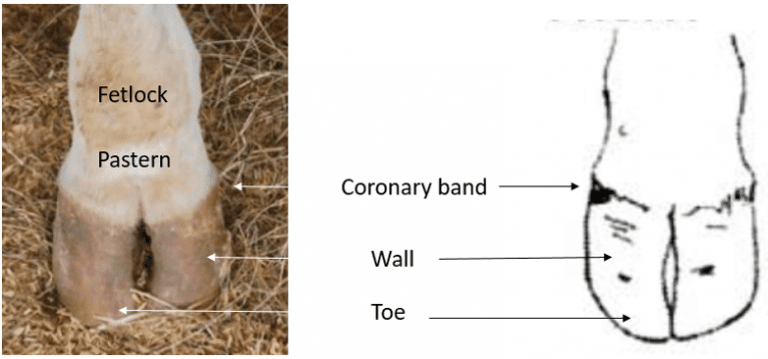
* The coronet, or coronary band, is a part of a horse’s leg just above the hoof, as illustrated here.
The research was conducted on two research stations in Queensland and some 5352 animals were recorded at birth for weight and their coronet circumference.
Three tropically adapted breeds were included in the project: Brahman, Droughtmaster and Santa Gertrudis.
The data collected over the project revealed some interesting outcomes. On average the calves in the project had a birth weight of 34kg, however the range in weight extended from 17kg to 54kg.
The average coronet circumference, which was measured using a commercial measuring tape designed for this purpose, was 16.5cm. The range in coronet circumference was also fairly broad, from 13.5cm to 20cm. The analysis of this data showed there was a raw correlation of 0.67 between birth weight and coronet circumference.
However, it’s important to note that the variation in birth weight for a given circumference was very broad. For the average circumference of 16.5cm, birth weights ranged from 22.5kg to 50kg. This suggests that birth weight is influenced by other factors and not just skeletal structure.
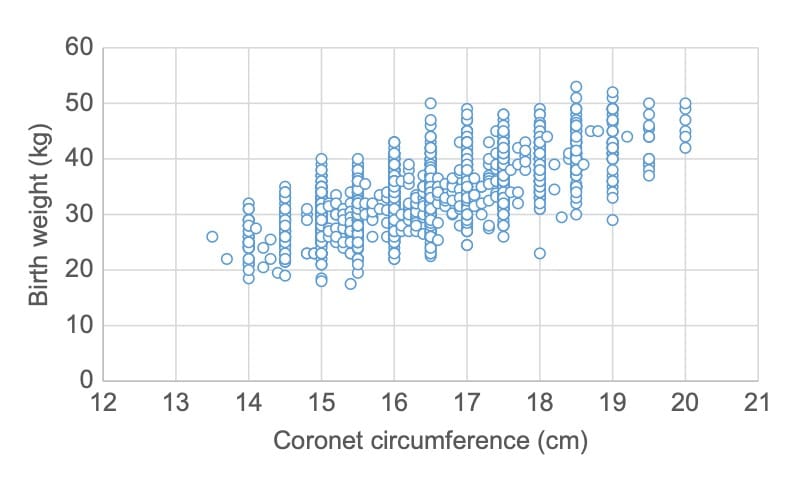
The relationship between the actual birth weight and coronet circumference at birth. Source: An investigation into potential genetic predictors of birth weight in tropically adapted beef cattle in northern Australia – K. L. Moore, D. J. Johnston and T. P. Grant
A major consideration of the research was to evaluate alternatives to measurement of birth weight. The calves were weighed and measured not only at birth but also at three months (branding) and six months (weaning). Coronet circumference was strongly correlated with liveweight measurements that occurred at the same time.
The correlation between birth weight and weaning weight does suggest that in selecting for heavier weaning weights will result in increased birth weights. Ideally, to overcome the difficulty of recording birth weights, using a single time point event to collect data and then submit it for analysis was seen as a potential opportunity for the extensive beef industry. However this will only work effectively when the actual age of the calves is known.
It was found that if birth date was unknown, the size of the genetic correlation of birth weight with post birth weight, as well as the level of heritability were significantly impacted. Removing age from the data collected at branding (three months of age) this saw heritability fall from 0.36 to 0.17 and the genetic correlation from 0.8 to 0.62.
In practical terms this means that to collect data at an event such as branding where the age of calves is not generally known, there is less opportunity to add to the evaluation of birth weight than many people may hope. Taking an additional measurement such coronet circumference doesn’t improve that opportunity much either, as illustrated below.
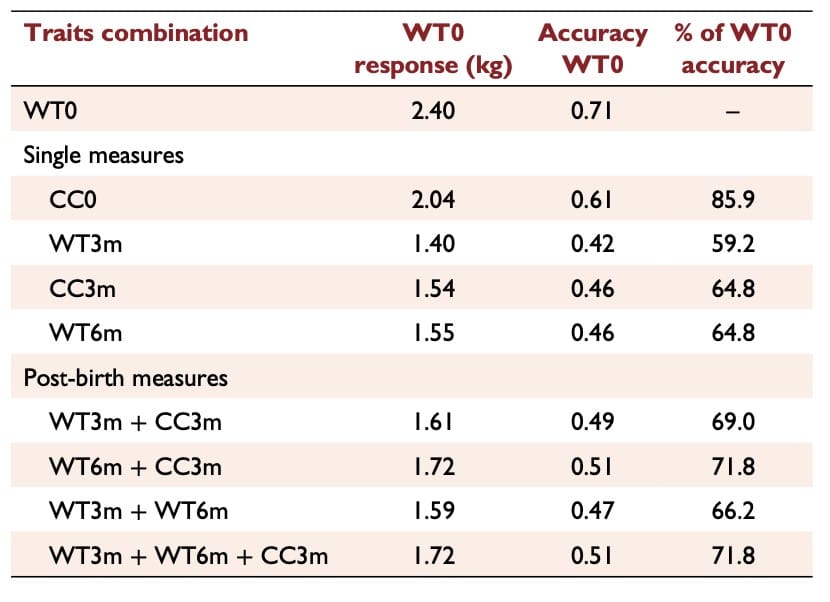
Predicted response and accuracy of selection for birth weight (WT0, kg) on the basis of various combinations of recorded correlated traits of birth coronet circumference (CC0, cm), 3-month weight (WT3m, kg), 3-month coronet circumference (CC3m, cm) and 6-month weight (WT6m, kg).
The project found that if coronet circumference was to be used as an alternative to weighing birth weight, the most accurate measurements were those taken at birth.
This basically means that there is no viable alternative to measuring birth weight. The research concluded by stating that
“Coronet circumference measured in the branding cradle has the advantage that calves do not need to be handled at birth and could be recorded on a single day. The trait was highly heritable, but the index accuracy for predicting birth weight was no better than simply recording a three-month or weaning liveweight.”
The research team did suggest that
“while branding or weaning weights could be used in genetic evaluation, provided the animal’s age was known, but without an actual birth weight record, the evaluation would have no capacity to identify those animals where birth weight genetics differs from their later growth.”
The risk for the industry more broadly is that without continued birth weight analysis, and reliance or greater selection pressure being placed more on branding or weaning weights, the flow-on effect will see birth weights continue to increase, with the associated risks of cow and calf mortality.
The challenge, particularly for seedstock producers within the tropically adapted herds, will be to potentially explore more effective and reliable methods of collecting birth weights during the calving season.
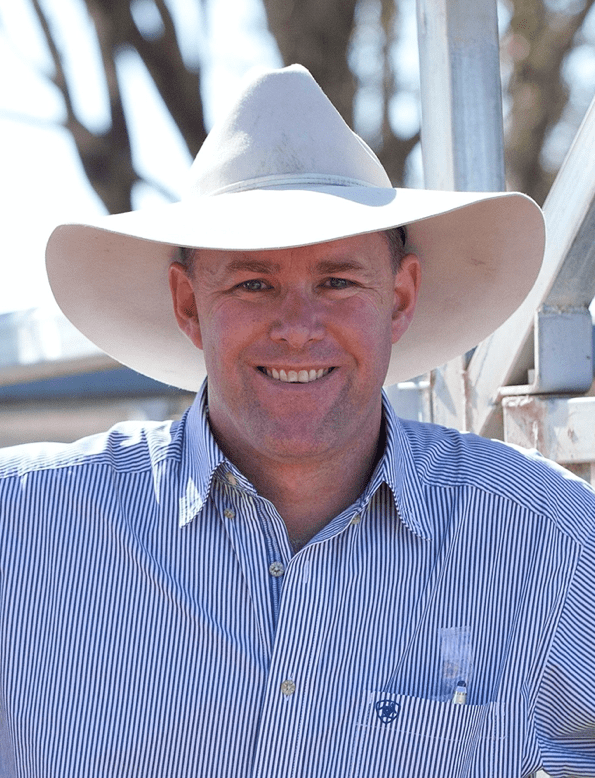 Alastair Rayner is the Principal of RaynerAg, an agricultural advisory service based in NSW. RaynerAg is affiliated with BJA Stock & Station Agents. He regularly lists and sell cattle for clients as well attending bull sales to support client purchases. Alastair provides pre-sale selections and classifications for seedstock producers in NSW, Qld, and Victoria. He can be contacted here or through his website www.raynerag.com.au
Alastair Rayner is the Principal of RaynerAg, an agricultural advisory service based in NSW. RaynerAg is affiliated with BJA Stock & Station Agents. He regularly lists and sell cattle for clients as well attending bull sales to support client purchases. Alastair provides pre-sale selections and classifications for seedstock producers in NSW, Qld, and Victoria. He can be contacted here or through his website www.raynerag.com.au
